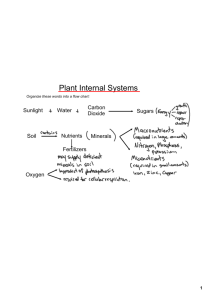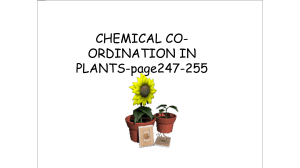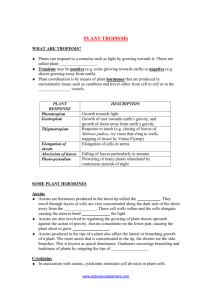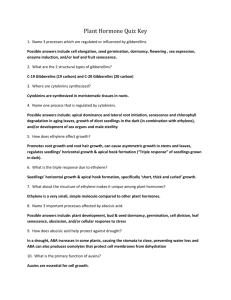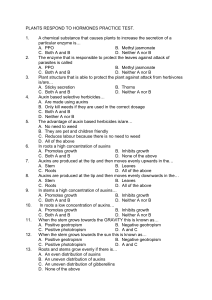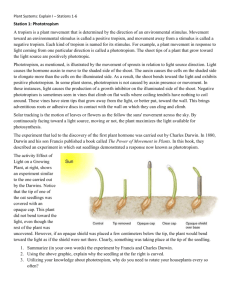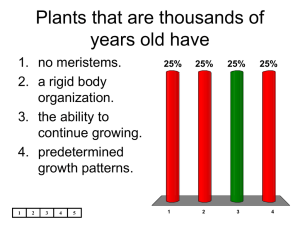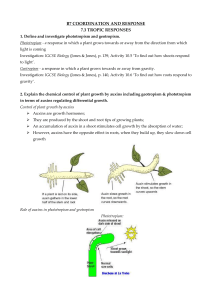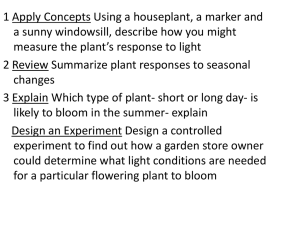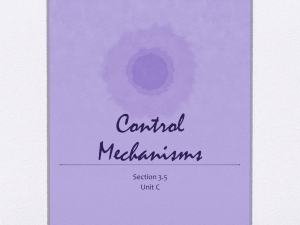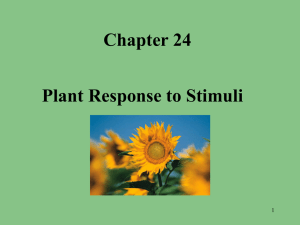Unit 7 Plants - Jamestown School District
advertisement
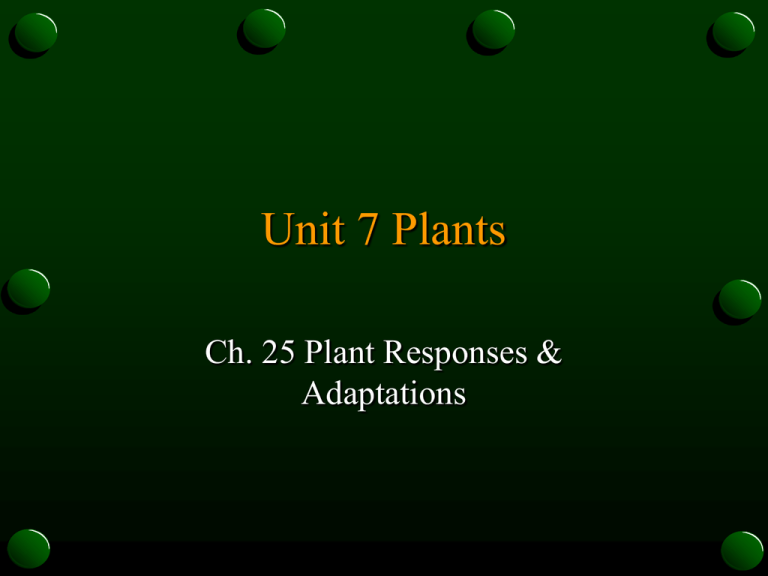
Unit 7 Plants Ch. 25 Plant Responses & Adaptations Plant Hormones Hormone - a substance that is produced in 1 part of an organism & affects another part of the same individual (a chemical messenger) Plant hormones are chemical substances that control a plant’s patterns of growth & development, & the plant’s responses to environmental conditions Plant Hormones Target cell - the portion of an organism affected by a particular hormone Auxins Phototropism - the tendency of a plant to grow toward a source of light Auxins - substances produced by the tip of each seedling that regulate cell growth Auxins Auxins are produced in the apical meristem & are transported downward into the rest of the plant They stimulate cell elongation Auxins & Gravitropism Gravitropism - the response of a plant to the force of gravity, caused by auxins In stems, auxins stimulate cell elongation, helping turn the trunk upright In roots, auxins inhibit cell growth & elongation, causing the roots to grow downward Auxins & Branching Lateral bud - a meristematic area on the side of a stem that gives rise to side branches Apical dominance - the closer a bud is to the stem’s tip, the more it is inhibited, because auxins move out from the apical meristem Auxinlike Weed Killers Herbicides - compounds that are toxic to plants, many contain high concentrations of auxins since auxins inhibit growth Cytokinins Cytokinins - plant hormones that are produced in growing roots & in developing fruits & seeds In plants, cytokinins stimulate cell division & growth of lateral buds, & cause dormant seeds to sprout Gibberellins Gibberellin - a growth-promoting substance Gibberellins produce dramatic increases in size, particularly in stems & fruit Ethylene Ethylene - 1 of the minor components of natural gas In response to auxins, fruit tissues release small amounts of the hormone ethylene Ethylene then stimulates fruits to ripen Tropisms Tropisms - the responses of plants to external stimuli Plant tropisms include gravitropism, phototropism, & thigmotropism Each of these responses demonstrates the ability of plants to respond effectively to external stimuli, such as gravity, light, & touch Gravitropism & Phototropism Gravitropism - the response of a plant to gravity Phototropism - the response of a plant to a light source Thigmotropism Thigmotropism - the response of a plant to touch Photoperiodism Short-day plants - plants that flower when the days are short Ex.) Poinsettias, & chrysanthemums Long-day plants - plants that flower when the days are long Ex.) Spinach, & irises Photoperiodism Photoperiodism - a plant’s response to light & dark Photoperiodism in plants is responsible for the timing of seasonal activities such as flowering & growth Phytochrome - a plant pigment that is responsible for photoperiodism (absorbs red light) Winter Dormancy - the period when an organism’s growth & activity decrease or stop As cold weather approaches, deciduous plants turn off photosynthetic pathways, transport materials from leaves to roots, & seal leaves off from the rest of the plant Dormancy Leaf Abscission Abscission layer - layer of cells at the petiole seals the leaf off from the plant’s vascular system Before long, the leaf falls to the ground, a sign that the tree is fully prepared for winter Aquatic Plants To take in sufficient oxygen, many aquatic plants have tissues with large air-filled spaces through which oxygen can diffuse Desert Plants Xerophytes - plants that live in the desert Plant adaptations to a desert climate include extensive roots, reduced leaves, & thick stems that can store water Nutritional Specialists Plants that have specialized features for obtaining nutrients include carnivorous plants (digest insects) & parasites Parasites grow into tissues of their host plant & extract water & nutrients, causing harm to host Epiphytes Epiphytes - plants that are not rooted in soil, but instead grow directly on the bodies of other plants Found mostly in the tropical rain forest Chemical Defenses Many plants defend themselves against insect attack by manufacturing compounds that have powerful effects on animals
